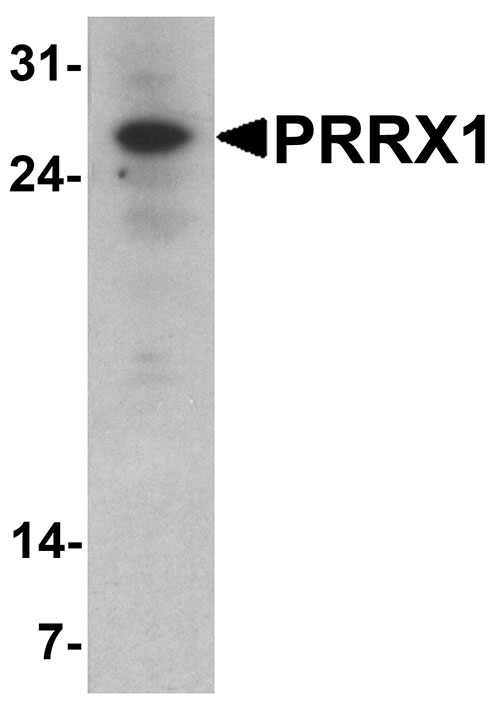PRRX1 Antibody
- SPECIFICATION
- CITATIONS
- PROTOCOLS
- BACKGROUND

Application
| WB, E |
|---|---|
| Primary Accession | P54821 |
| Other Accession | NP_073207, 12707577 |
| Reactivity | Human, Mouse, Rat |
| Host | Rabbit |
| Clonality | Polyclonal |
| Isotype | IgG |
| Calculated MW | Predicted: 27 kDa Observed: 26 kDa |
| Application Notes | PRRX1 antibody can be used for detection of PRRX1 by Western blot at 1 - 2 µg/ml. |
| Gene ID | 5396 |
|---|---|
| Target/Specificity | PRRX1; PRRX1 antibody is human, mouse and rat reactive. At least two isoforms of PRRX1 are known to exist; this antibody will detect both isoforms. |
| Reconstitution & Storage | PRRX1 antibody can be stored at 4℃ for three months and -20℃, stable for up to one year. |
| Precautions | PRRX1 Antibody is for research use only and not for use in diagnostic or therapeutic procedures. |
| Name | PRRX1 |
|---|---|
| Synonyms | PMX1 |
| Function | Master transcription factor of stromal fibroblasts for myofibroblastic lineage progression. Orchestrates the functional drift of fibroblasts into myofibroblastic phenotype via TGF-beta signaling by remodeling a super-enhancer landscape. Through this function, plays an essential role in wound healing process (PubMed:35589735). Acts as a transcriptional regulator of muscle creatine kinase (MCK) and so has a role in the establishment of diverse mesodermal muscle types. The protein binds to an A/T-rich element in the muscle creatine enhancer (By similarity). May play a role in homeostasis and regeneration of bone, white adipose tissue and derm (By similarity). |
| Cellular Location | Nucleus {ECO:0000250|UniProtKB:P63013}. |
| Tissue Location | [Isoform 1]: Widely expressed in embryonic and adult tissues, with highest levels in skeletal muscle. Isoform 1 is either expressed at similar or higher levels compared to isoform 2 in all embryonic tissues but skeletal muscle and heart. In adult tissues, expressed at lower levels compared to isoform 2 |

Thousands of laboratories across the world have published research that depended on the performance of antibodies from Abcepta to advance their research. Check out links to articles that cite our products in major peer-reviewed journals, organized by research category.
info@abcepta.com, and receive a free "I Love Antibodies" mug.
Provided below are standard protocols that you may find useful for product applications.
Background
The paired related homeobox protein 1 (PRRX1) is a paired-type DNA-binding homeodomain that plays an important role as a key switch for neural cell lineage determination and is essential for development (1,2). PRRX1 is expressed in a number of undifferentiated mesenchymal cells in mouse embryos and adults (3). Mice with a disrupted PRRX1 gene show perinatal death with craniofacial and limb malformations (4). Low PRRX1 expression levels were significantly associated with metastasis and poor prognosis of breast and colorectal cancer (5).
References
Nohno T, Koyama E, Myokai F, et al. Chicken homeobox gene related to Drosophila paired is predominantly expressed in the developing limb. Dev. Biol. 1993; 158:254–64.
Shimozaki K, Clemenson GD Jr, and Gage FH. Paired related homeobox protein 1 is a regulator of stemness in adult neural stem/progenitor cells. J. Neurosci. 2013; 33:4066-75.
Cserjesi P, Lilly B, Bryson L, et al. MHox: a mesodermally restricted homeodomain protein that binds an essential site in the muscle creatine kinase enhancer. Development 1992; 115:1087–101.
Lu MF, Cheng HT, Kern MJ, et al. prx-1 functions cooperatively with another paired-related homeobox gene, prx-2, to maintain cell fates within the craniofacial mesenchyme. Development 1999; 126:495–504.
If you have used an Abcepta product and would like to share how it has performed, please click on the "Submit Review" button and provide the requested information. Our staff will examine and post your review and contact you if needed.
If you have any additional inquiries please email technical services at tech@abcepta.com.













 Foundational characteristics of cancer include proliferation, angiogenesis, migration, evasion of apoptosis, and cellular immortality. Find key markers for these cellular processes and antibodies to detect them.
Foundational characteristics of cancer include proliferation, angiogenesis, migration, evasion of apoptosis, and cellular immortality. Find key markers for these cellular processes and antibodies to detect them. The SUMOplot™ Analysis Program predicts and scores sumoylation sites in your protein. SUMOylation is a post-translational modification involved in various cellular processes, such as nuclear-cytosolic transport, transcriptional regulation, apoptosis, protein stability, response to stress, and progression through the cell cycle.
The SUMOplot™ Analysis Program predicts and scores sumoylation sites in your protein. SUMOylation is a post-translational modification involved in various cellular processes, such as nuclear-cytosolic transport, transcriptional regulation, apoptosis, protein stability, response to stress, and progression through the cell cycle. The Autophagy Receptor Motif Plotter predicts and scores autophagy receptor binding sites in your protein. Identifying proteins connected to this pathway is critical to understanding the role of autophagy in physiological as well as pathological processes such as development, differentiation, neurodegenerative diseases, stress, infection, and cancer.
The Autophagy Receptor Motif Plotter predicts and scores autophagy receptor binding sites in your protein. Identifying proteins connected to this pathway is critical to understanding the role of autophagy in physiological as well as pathological processes such as development, differentiation, neurodegenerative diseases, stress, infection, and cancer.


